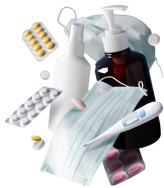Healthwire Pharmacy provides 100% genuine medicines straight to your doorstep.
Order Now! & Avail
Upto 10% OFF On All Your Pharmacy Orders!
Healthwire Pharmacy Ratings & Reviews (1500+)
Product Information
Nepafenac, a non-steroidal anti-inflammatory drug (NSAID), primarily acts by inhibiting the cyclooxygenase (COX) enzymes, COX-1 and COX-2, which are involved in the synthesis of prostaglandins. When administered in the form of eye drops, nepafenac penetrates the cornea and undergoes rapid metabolism to amfenac, its active form. Amfenac selectively blocks the COX enzymes, particularly COX-2, which is responsible for the production of inflammatory mediators such as prostaglandins and thromboxanes. By inhibiting the production of these inflammatory substances, nepafenac helps reduce pain, inflammation, and ocular discomfort associated with various eye conditions. This mechanism of action makes nepafenac effective in managing postoperative inflammation and pain following cataract surgery or other ocular procedures.
Nonsteroidal anti-inflammatory drug (NSAID)
Drop
The following are the uses of Nepafenac Drop:
Tailoring Treatment for Optimal Health, Prescribed Medication Dosage is:
In the case of an overdose of Nepafenac Drops, it is important to remain calm and take prompt action. Contact a healthcare professional or a poison control center immediately for guidance. They will provide specific instructions based on the amount ingested and individual factors. Quick response can help mitigate potential adverse effects, as healthcare providers may recommend appropriate measures such as inducing vomiting or administering activated charcoal to minimize the impact of the overdose.
In the case of a missed dose of Nepafenac Drops, it is important to administer the medication as soon as you remember. If it is almost time for your next dose, skip the missed dose and continue with your regular dosing schedule. Do not double the dose to make up for a missed one. It is best to use the medication at evenly spaced intervals as prescribed by your healthcare professional. If you have any concerns or frequently miss doses, consult your doctor or pharmacist for guidance on how to adjust your dosing schedule.
To administer Nepafenac eye drops, gently tilt your head back, hold the dropper close to your eye, and place the prescribed number of drops into the lower eyelid, then close your eyes for 1-2 minutes to allow the medication to absorb.
Here are the conditions or situations when Nepafenac eye drops should not be used:
The side effects of Nepafenac Eye Drops may include:
Following are the precautions and warnings for Nepafenac Eye Drops:
Following are the drug interactions for Nepafenac Eye Drops:
Following are the food interactions for Nepafenac Drops:
Nepafenac eye drops should be stored properly to maintain their effectiveness and safety. Keep the unopened bottles in a cool, dry place, preferably between 68°F and 77°F (20°C and 25°C). Once opened, store the bottle in an upright position at room temperature, away from excessive heat and direct sunlight. It is crucial not to freeze the eye drops. Always replace the cap tightly after each use to prevent contamination. Before applying the drops, check the liquid for any discoloration or particles. If you notice any signs of deterioration or if the drops have passed their expiration date, do not use them and dispose of them properly. Consult your pharmacist or healthcare provider for appropriate disposal methods, and keep the medication away from children to prevent accidental exposure.
Following are the quick tips for Nepafenac Drops:
When taking Nepafenac 0.1%, it is vital to undergo specific laboratory tests to ensure your safety and adjust the dosage if required. These tests are crucial due to the potential stress on your liver and kidneys from the medication. Among the critical tests are a liver function test, kidney function test, and an eye examination. The liver function test helps assess the liver's well-being, examining enzymes such as ALT and AST, which indicate liver injury. The kidney function test, consisting of blood urea nitrogen and creatinine measurements, is necessary to monitor stress on the kidneys caused by Nepafenac 0.1%'s excretion.Regular eye exams are advised to monitor the condition's progression and the medication's efficacy. These exams assess eye pressure, visual acuity, and eye redness to ensure the eyes respond suitably to the treatment.

Order Now! & Avail
Upto 10% OFF On All Your Pharmacy Orders!

If you face any issue, feel free to contact us. We provide 24/7 support to assist your problems